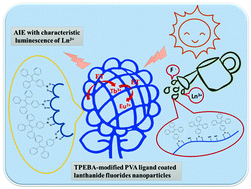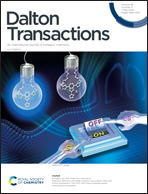Constructing a tetraphenylethene (TPE) derivative-decorated polyvinyl alcohol (PVA)/lanthanide nanoparticle composite system for tunable luminescence†
Abstract
A novel tetraphenylethene (TPE) derivative-decorated lanthanide nanomaterial NaLnF4 (denoted as TPEBA–Ln, Ln = Gd3+, Tb3+ and Eu3+) was hydrothermally synthesized using (4-(1,2,2-triphenylvinyl)phenyl) boronic acid (TPEBA)-modified polyvinyl alcohol (PVA) as a coating ligand. Interestingly, the aggregation-induced emission (AIE) of the TPE moiety was activated because the intramolecular rotation of TPEBA was restricted via the esterification of TPEBA with PVA. More excitingly, it was found for the first time that the TPEBA-based ligand could further act as a donor and transfer energy to the lanthanide nanoparticle (Ln = Eu3+ and Tb3+) acceptor in this TPEBA–Ln system. Encouragingly, TPEBA had advantageous effects on the emission of the composite material, in which a more effective energy transfer process from the ligand to lanthanide ions was observed when TPEBA tended to be isolated on the surface of the nanoparticles. Furthermore, the material combining different ratios of TPEBA, Tb3+ and Eu3+ displayed tunable luminescence properties covering the wavelength range from 400 nm to 700 nm in the visible region due to the established energy transfer path (tetraphenylethene derivative-Tb3+–Eu3+), which provided a facile and effective strategy to obtain potential full-color emitters. Strikingly, distinct luminescence properties were induced by adding different PVA samples. When PVA with a higher hydrodynamic radius (Rh) and more curly structure was added, it substituted some TPEBA molecules and then twined around the surface to lock and isolate the remaining TPEBA molecules, resulting in a blueshift in the peak together with increased intensity in the emission spectrum. However, only attenuated aggregate emission was observed upon the addition of PVA with a lower Rh and more stretched chains because the arrangement of the TPEBA left on the surface was not significantly affected by the displacement of this type of PVA. This discovery may provide a facile approach to design and prepare more promising candidates as tunable optical composite materials and TPE-based fluorescent sensors.



 Please wait while we load your content...
Please wait while we load your content...